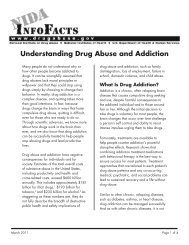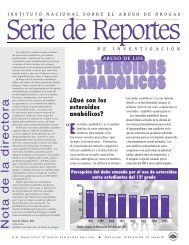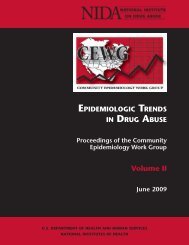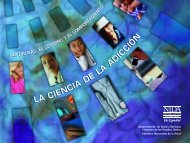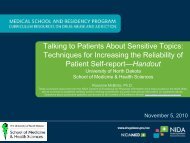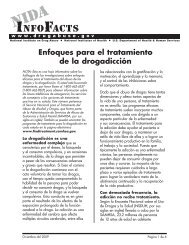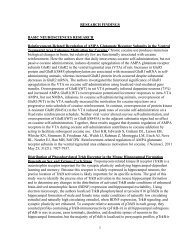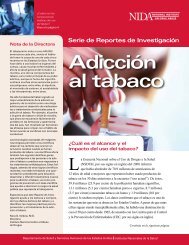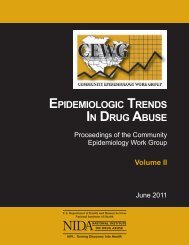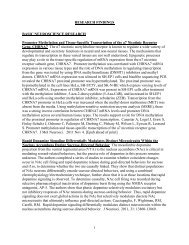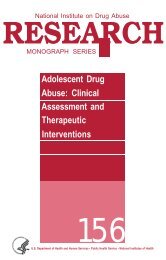CEWG January 09 Full Report - National Institute on Drug Abuse
CEWG January 09 Full Report - National Institute on Drug Abuse
CEWG January 09 Full Report - National Institute on Drug Abuse
You also want an ePaper? Increase the reach of your titles
YUMPU automatically turns print PDFs into web optimized ePapers that Google loves.
Secti<strong>on</strong> III. <str<strong>on</strong>g>CEWG</str<strong>on</strong>g> Area Update Briefs and Internati<strong>on</strong>al Presentati<strong>on</strong>s<br />
the illicit drug most often reported by these admissi<strong>on</strong>s.<br />
Cocaine c<strong>on</strong>stituted 9 percent of treatment<br />
admissi<strong>on</strong>s reporting a primary drug. The<br />
number of cocaine treatment admissi<strong>on</strong>s decreased<br />
from 227 in the first half of 2007 to 183<br />
in the first half of 2008. After rising steadily during<br />
2005 and 2006, cocaine-related hospital admissi<strong>on</strong>s<br />
began declining in the first half of 2007,<br />
and c<strong>on</strong>tinued declining through the first half of<br />
2008. Cocaine seizures were lower in the sec<strong>on</strong>d<br />
quarter of 2008 compared with the first quarter.<br />
Thirty-six MDMA items were reported by NFLIS<br />
during the first half of 2008, a small number when<br />
compared with that for methamphetamine items<br />
(n=763). Marijuana was the primary drug reported<br />
by 15 percent of the treatment admissi<strong>on</strong>s<br />
reporting a primary drug. Marijuana treatment<br />
admissi<strong>on</strong>s increased slightly, from 292 in the first<br />
half of 2007 to 3<str<strong>on</strong>g>09</str<strong>on</strong>g> in the first half of 2008. Marijuana<br />
seizures dropped slightly in the first quarter<br />
of 2008 and increased slightly in the sec<strong>on</strong>d quarter<br />
of 2008. Much of the marijuana smuggled into<br />
Ariz<strong>on</strong>a comes through a remote “transportati<strong>on</strong><br />
corridor” west of Nogales, Mexico. This corridor<br />
runs through the Toh<strong>on</strong>o O’odham Indian Reservati<strong>on</strong>,<br />
which lies al<strong>on</strong>g the United States–Mexico<br />
border. It is estimated that traffckers transport as<br />
much as 20 t<strong>on</strong>s of marijuana per week through<br />
this corridor. Heroin was the primary drug reported<br />
by 13 percent of the treatment admissi<strong>on</strong>s<br />
reporting a primary drug. Heroin admissi<strong>on</strong>s increased<br />
from 231 in the first half of 2007 to 257 in<br />
the first half of 2008. Hospital admissi<strong>on</strong>s related<br />
to heroin/opioids have been rising fairly steadily<br />
since 2000. C<strong>on</strong>sistent with this, heroin/opioidrelated<br />
admissi<strong>on</strong>s rose in the first half of 2008.<br />
Although Ariz<strong>on</strong>a has been almost exclusively a<br />
black tar heroin area for decades, recent seizures<br />
indicate that Phoenix may now serve as a feeder<br />
city for white heroin arriving from Mexico. The<br />
white heroin is being transported to midwestern<br />
and northeastern wholesale distributi<strong>on</strong> markets;<br />
to date, white heroin has not been encountered by<br />
local wholesale or street level distributors based<br />
in the Phoenix area. According to the Automati<strong>on</strong><br />
of <str<strong>on</strong>g>Report</str<strong>on</strong>g>s and C<strong>on</strong>solidated Orders System<br />
(ARCOS) operated by the <strong>Drug</strong> Enforcement<br />
Administrati<strong>on</strong> (DEA), Ariz<strong>on</strong>a’s per capita retail<br />
sales of oxycod<strong>on</strong>e, morphine, and methad<strong>on</strong>e<br />
are substantially greater than those of the Nati<strong>on</strong><br />
as a whole. Hydrocod<strong>on</strong>e per capita sales in Ariz<strong>on</strong>a<br />
and the Nati<strong>on</strong> were roughly comparable.<br />
HIV/AIDS Update: New data were unavailable<br />
to update rates reported at the June 2008 meeting.<br />
Emerging Patterns Regarding Use: Agwa de<br />
Bolivia Coca Leaf Liqueur reportedly had become<br />
popular in bars and clubs in the Phoenix area in<br />
2008. It is also sold at a limited number of liquor<br />
stores. Advertisements indicate that it provides<br />
a “cocaine buzz” and is made from the leaves of<br />
the coca plant as well as ginseng, green tea, and<br />
a natural source of caffeine called guarana. The<br />
drink is 60-percent alcohol; however, many users<br />
state they get more of a “drug high” than a “liquor<br />
buzz.” The coca leaves used to manufacture it<br />
are the leaves from which cocaine alkaloids have<br />
been removed. The substance is made in Amsterdam<br />
and legally imported into the United States<br />
Emerging Patterns Regarding Smuggling: There<br />
are reports of smugglers: (1) ramming U.S. Border<br />
Patrol vehicles and driving directly toward agents<br />
at high rates of speed in attempts to hit them;<br />
(2) intenti<strong>on</strong>ally causing accidents and incidents<br />
to distract law enforcement offcers; (3) faking<br />
distress calls in order to lure agents into attack;<br />
and (4) now being more likely to shoot at offcers<br />
in order to avoid apprehensi<strong>on</strong>.<br />
Data Sources: Treatment data were provided<br />
by the Ariz<strong>on</strong>a Department of Health Services<br />
(ADHS), Divisi<strong>on</strong> of Behavioral Health Services.<br />
Hospital admissi<strong>on</strong>s (inpatient) data were<br />
derived from analyses c<strong>on</strong>ducted by the University<br />
of Ariz<strong>on</strong>a, Department of Family and Community<br />
Medicine using hospital discharge records from the<br />
Ariz<strong>on</strong>a Hospital Discharge Data System operated<br />
by the ADHS. Law enforcement data, including<br />
clandestine lab seizure data, were from the DEA<br />
and the <str<strong>on</strong>g>Nati<strong>on</strong>al</str<strong>on</strong>g> <strong>Drug</strong> Intelligence Center. Forensic<br />
drug analysis data came from NFLIS, DEA. Data<br />
<strong>on</strong> the retail distributi<strong>on</strong> of selected prescripti<strong>on</strong><br />
opioid medicati<strong>on</strong>s were obtained from ARCOS.<br />
Proceedings of the Community Epidemiology Work Group, <str<strong>on</strong>g>January</str<strong>on</strong>g> 20<str<strong>on</strong>g>09</str<strong>on</strong>g> 61



